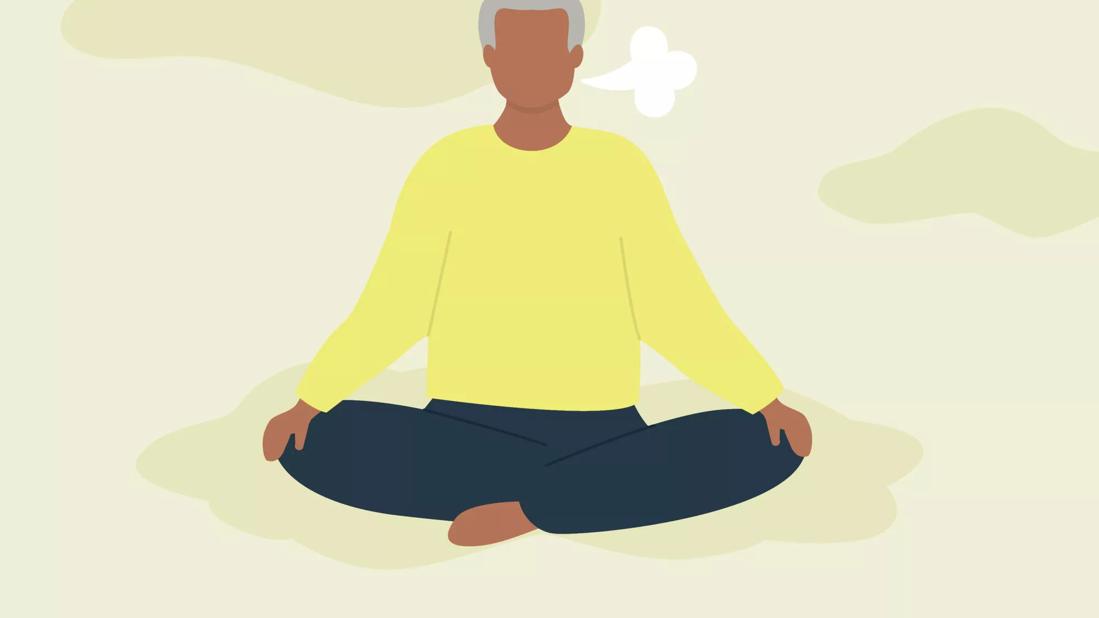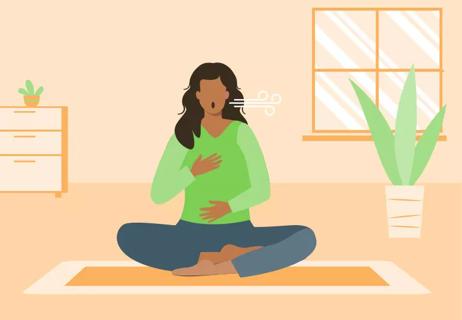Breathing techniques may help move your body into a more relaxed and stress-free state

As ’80s film icon Ferris Bueller once said, “Life comes at you fast.” But when things seem to be moving a bit too quickly for you to handle, breathing techniques can help melt your stress away.
Advertisement
Cleveland Clinic is a non-profit academic medical center. Advertising on our site helps support our mission. We do not endorse non-Cleveland Clinic products or services. Policy
Functional and integrative medicine specialist Melissa Young, MD, explains the science of breathing and how embracing the art of breathwork can bring you the peace and calm you crave, even in the most hectic of moments.
Breathwork refers to breathing techniques that intentionally channel and focus on the breath. For thousands of years, Eastern medicine practices, including Ayurveda and traditional Chinese medicine, have employed breathing techniques to calm the body and the mind.
“Our minds tend to be very active, often thinking about the past and worrying about the future instead of residing in the present moment,” Dr. Young explains. “This can lead to the activation of stress hormones for extended periods of time, which can have adverse effects on the body. Chronic stress increases the risk of a number of diseases and disease processes in the body.”
It’s no secret that mental and emotional stress can manifest in physical ways, playing a role in issues like:
But stress management techniques — including breathwork — are one way to help you step back from the chaos and keep your mind and body healthy.
Advertisement
Breathwork helps calm you down and move your body and mind out of fight-or-flight mode. To understand how, though, you need to know about your autonomic nervous system, which consists of two parts:
Fight-or-flight mode is helpful when you’re being chased by a bear or fleeing a burning building. But these days, many of us are in a mental fight-or-flight mode even when our bodies aren’t under physical duress — think major work deadlines, upsetting news headlines, financial woes, arguments with your spouse and more.
“We need our sympathetic nervous system to be aware of danger in our environment, but in today’s society, we’re too often in fight-or-flight mode when we’re not actually in danger,” Dr. Young explains. “We need to be able to tap into our parasympathetic nervous system to be able to calm sensations of stress.
Breathwork, then, is a way to activate your body’s parasympathetic nervous system and help you de-escalate and de-stress. That can also lead to all kinds of positive feelings.
“Breathwork helps us with focus and energy, which can lead to a better quality of life where there’s space for joy and fun,” Dr. Young adds. “If we’re constantly in a state of stress and tension, it’s very hard to find those important qualities in life.”
Joy and fun? Yes, please! Plus, breathwork is one of the most accessible wellness practices out there. Anyone can do it, regardless of age or other medical conditions, so long as you find the breathing techniques that work best for you.
There are a variety of breathwork techniques you can try, all of them with a similar goal — to help you destress. “It’s all about finding the technique that resonates with you,” Dr. Young notes. “There are so many that it can be exciting to try different ones to see what works for you.”
You can also tap into different techniques at different times, depending on your goal and your circumstances. Box breathing, for example, can be done on the go from just about anywhere (OK, not while you’re driving), while 4-7-8 breathing, which is a bit more complex, is great for helping you fall into a deep sleep.
Here’s a look at various types of breathwork practices, what they can do for you and when you might want to try them.
Advertisement
When you do diaphragmatic breathing, you engage your diaphragm, a powerful muscle at the base of your lungs. Also known as abdominal breathing or belly breathing, this technique has been shown to help lower blood pressure and heart rate, and it’s especially beneficial for people with lung conditions.
But anyone can do it — and Dr. Young says it’s a good starting point for breathwork newbies.
“This is a perfect place to start, especially if you’re new to breathwork because you can do it either sitting or lying down, just focusing on your belly gently rising with your breath in and falling with your breath out,” Dr. Young encourages. “It’s a great way to relax and relieve stress.”
When to try it: Honestly … any time! “If you’re in a stressful situation, no one even needs to know you’re practicing a little bit of slow breathing,” she says. And practicing for just a few minutes a day will allow you to better tap into it in times of stress.
Box breathing is one of the simplest and most common forms of yogic deep breathing.
Like a box, which has four sides, this technique has four steps: Four counts of breathing in, four counts of holding your breath, four counts of exhaling and four more counts of holding after your exhale.
Advertisement
“As you’re breathing, you’re also silently counting, which is a kind of mantra meditation that can calm the nervous system and anchor you into the present moment,” Dr. Young notes. “It helps bring us back into our bodies and away from the distractions of the world.”
When to try it: As one of the most accessible forms of breathwork, box breathing is another great anytime practice. Do it when you need a quick midday pick-me-up from your desk or when you’re trying to chill out after somebody cuts you in line at the coffee shop.
The 4-7-8 breathing technique can be done while sitting comfortably or lying down before bedtime.
The numbers refer to how long you inhale (four counts), hold (seven counts) and exhale (eight counts.) “This kind of breathing can help us focus our mind and our body away from worries and repetitive thoughts,” Dr. Young says.
When to try it: Who needs sheep? 4-7-8 breathing has been shown to help you get a good night’s sleep by calming the mind, reducing anxiety and decreasing heart rate and blood pressure.
Sometimes called channel-clearing breath, alternate nostril breathing, known in Sanskrit as Nadī Shodhana, has historically been said to clear energy blockages and bring about inner balance (though, there’s no scientific evidence of those claims). Studies do show that it may help sharpen your focus and energy, making you feel not just calm, but also invigorated.
Advertisement
“To do it, you isolate each nostril, breathing in through only one of them at a time and then exhaling through the other,” Dr. Young explains. It takes some practice to get it right, but once you get the hang of it, it can be a powerful relaxation tool.
When to try it: Give this one a go in the middle of a stressful workday or before a big presentation to get yourself feeling clear-headed and ready to conquer the world.
Pursed lip breathing is a way to slow down your breathing and reduce your stress levels. To “purse” your lips, you pinch them inward, sort of like you would do to blow a kiss, then you slowly inhale through your nose and gently exhale through pursed lips.
It’s been shown to benefit people with lung conditions, like asthma and pulmonary fibrosis, who experience breathing troubles. But again, anyone can do it.
When to try it: Pursed lip breathing can help make physical exertion a little bit easier, so you may want to use it for activities like lifting and climbing stairs. But it’s best to practice it while you’re at rest, first, so you can really get the hang of it. It can also help you in prolonging your exhale, for example in the 4-7-8 breath exercise.
There’s very little research on the science of this one in particular, but lion’s breath, also known as simha pranayama, is thought to help relieve anxiety and bring about a sense of calm. Hakuna matata!
“When you do lion’s breath, you stick your tongue out as you exhale and make a big, whooshing ‘haaaa,’ sound,” Dr. Young explains. “It’s not a roar, exactly, but it’s a sort of yogic interpretation of one.”
When to try it: If social anxiety has you feeling on edge before (or even during) a get-together or large gathering, sneak off by yourself to do a couple rounds of this king-of-the-jungle-style breathing technique.
Five-finger breathing is a simple, powerful breathing technique that’s been shown to induce deep relaxation.
“Unlike other types of breathwork, this one is a multisensory practice,” Dr. Young states, “In addition to your breathing, also focus on the movement and sensation of one of your fingers slowly and intentionally tracing the other hand.”
When to try it: Some healthcare providers recommend that their patients do five-finger breathing before heading into surgery, as it’s thought to help your brain enter a state of deep relaxation and release endorphins — your body’s natural painkillers.
Holotropic breathing uses rapid, controlled breathing patterns to help you enter what’s often referred to as an “altered state of consciousness,” a dream-like experience that can help you cope with mental health conditions like depression, anxiety and chronic stress.
When to try it: This technique is a behavioral health therapy employed to help people cope with trauma, so it’s one you shouldn’t try without a trained facilitator. If you’re new to breathwork, try one of the other options on this list instead, and bring your questions about holotropic breathwork to your mental health provider.
Breathwork and meditation don’t always have to go together — but they can. If you hear the term “breathwork meditation” or “meditative breathwork,” they’re referring to combining elements of both practices.
“There are many different techniques for helping to calm the body and the mind,” Dr. Young says. “Both breathwork and meditation can serve as an interface between the body and the mind, and we can either separate them out or combine them.”
Body scan meditation, for example, harnesses deep breathing and mindfulness to help you feel grounded, aware and connected to your body.
When to try it: Do a body scan meditation during a stressful day or after a difficult workout to become more in tune with your body and how you’re feeling.
Dr. Young shares tips for getting started with breathing techniques.
To hear more on this topic, listen to the Health Essentials Podcast episode, “Breathwork for Beginners.” New episodes of the Health Essentials Podcast publish every Wednesday.
Learn more about our editorial process.
Advertisement

This supercharged oxygen treatment is unregulated and may do more harm than good

Focusing on regulating your breath can help calm your mind

Use your oxygen uptake number as a way to help you train or work out more efficiently

Keeping tabs on coronavirus symptoms

Breathing, exercise, mindfulness and more can help you unwind and step away from your stress

Move a little more, eat a little healthier, sleep a little better and destress a lot

From breath meditation to yoga nidra, all types of meditation aim to help you feel calmer, more relaxed and present

The best parenting style balances enforcing rules and showing plenty of love

Tips include cutting back on sugar, focusing on exercise and managing stress

It can be harder to let go when you’ve invested time, energy and emotions — but it might be the healthier choice long term